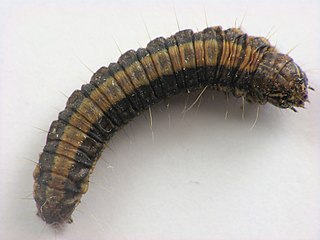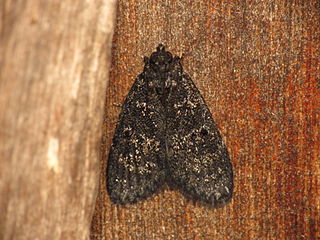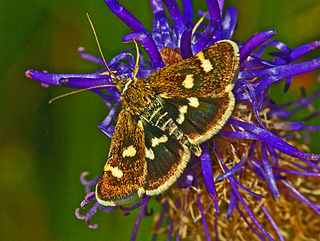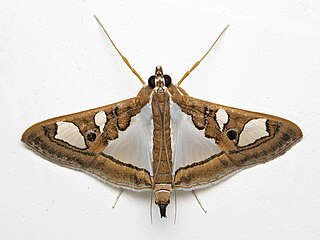
Attevidae is a family of moths of the Yponomeutoidea superfamily, containing only one genus, Atteva. The group has a pantropical distribution, but at least one species has a range that extends into the temperate zone. No consistent hypotheses regarding the relationships, placement, and ranking of Attevidae have been published, but the prevalent view is that they likely form a monophyletic group within the Yponomeutoidea.

Spilomelinae is a very species-rich subfamily of the lepidopteran family Crambidae, the crambid snout moths. With 4,132 described species in 340 genera worldwide, it is the most speciose group among pyraloids.

Crambinae is a large subfamily of the lepidopteran family Crambidae, the crambid snout moths. It currently includes over 1,800 species worldwide. The larvae are root feeders or stem borers, mostly on grasses. A few species are pests of sod grasses, maize, sugar cane, rice, and other Poaceae. The monophyly of this group is supported by the structure of the tympanal organs and the phallus attached medially to the juxta.

Calamotropha is a genus of moths of the family Crambidae.

Cirrhochrista is a genus of moths of the family Crambidae described by Julius Lederer in 1863.
Orphnophanes is a genus of moths of the family Crambidae described by Julius Lederer in 1863.

Lygropia is a genus of snout moths in the subfamily Spilomelinae of the family Crambidae. It currently comprises 66 species, which are mostly found in the tropical and subtropical regions of the Americas, Africa and Asia, but not in Australia.

Prionapteryx is a genus of moths of the family Crambidae.

The Chrysauginae are a subfamily of snout moths. They are primarily Neotropical and include about 400 described species.

The Epipaschiinae are a subfamily of snout moths. Almost 600 species are known today, which are found mainly in the tropics and subtropics. Some occur in temperate regions, but the subfamily is apparently completely absent from Europe, at least as native species. A few Epipaschiinae are crop pests that may occasionally become economically significant.

Catamola funerea is a species of snout moth in the genus Catamola. It was described by Francis Walker in 1863. It is found in Australia.

Catamola xanthomelalis is a species of snout moth in the genus Catamola. It was described by Francis Walker in 1863, and is known from Australia.
Jocara is a genus of snout moths. It was described by Francis Walker in 1863.
Emmalocera nigricostalis is a species of snout moth in the genus Emmalocera. It was described by Francis Walker in 1863. It is found in western Africa, India, Sri Lanka, Myanmar, Borneo, the Andamans, Fiji and Taiwan.

Odontiinae is a subfamily of moths of the family Crambidae. The subfamily was described by Achille Guenée in 1854.
Scirpophaga occidentella is a moth in the family Crambidae. It was described by Francis Walker in 1863. It is found in Angola, the Democratic Republic of the Congo, Ivory Coast, Madagascar, Malawi, Mozambique, Nigeria, Senegal, Sierra Leone, South Africa and Tanzania.
Compsoctena is a genus of moths in the family Eriocottidae. It was erected by Philipp Christoph Zeller in 1852.
Agroterini is a tribe of the species-rich subfamily Spilomelinae in the pyraloid moth family Crambidae. The tribe was erected by Alexandre Noël Charles Acloque in 1897.

Margaroniini is a tribe of the species-rich subfamily Spilomelinae in the pyraloid moth family Crambidae. The tribe was erected by Charles Swinhoe and Everard Charles Cotes in 1889.

Spilomelini is a tribe of the species-rich subfamily Spilomelinae in the pyraloid moth family Crambidae. The tribe was erected by Achille Guenée in 1854.













